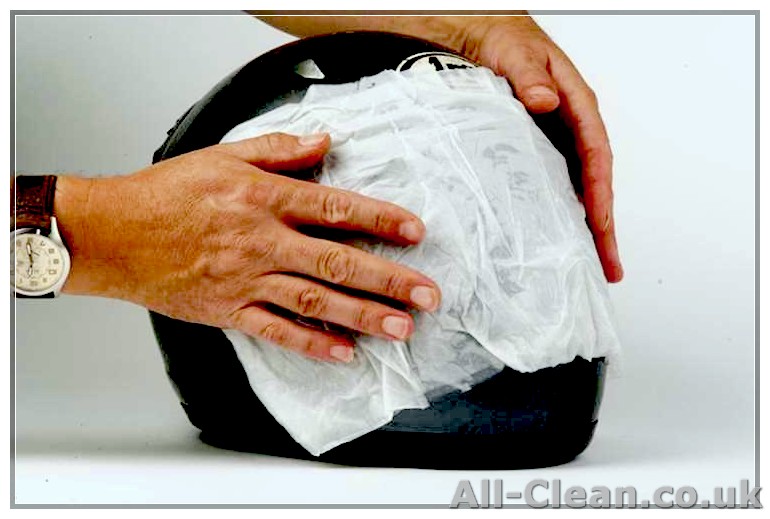
If you ride a bike, you know how important it is to regularly clean and take care of your helmet visor. A dirty visor can impair your vision on the road, which can be dangerous. But with a few DIY tips, you can save some money and keep your helmet visor clean and protected.
Previously, there were helmet visor cleaners on the market that claimed to clean and protect your visor, but many of them left scratches and damage behind. It wasn’t worth the risk to use these name-brand items and end up with a damaged visor.
The first step in cleaning your visor is to make sure you have the right cleaning items. You don’t want to use just any cleaning agent on your visor, as it may contain chemicals that can damage the plastic. Instead, opt for mild cleaning solutions like soapy water or a vinegar and water solution. These will remove dirt and grime without harming the visor.
One popular cleaning method is to use toothpaste. Squeeze a small amount of toothpaste onto a soft cloth and gently rub it onto the visor in circular motions. The toothpaste acts as a mild abrasive and can remove minor scratches and smudges. After a few seconds of rubbing, rinse the visor with water and dry it with a clean cloth. This process can be repeated as needed to keep your visor clean and clear.
If your visor has a Pinlock coating, be sure to treat it with care. Pinlock visors have a special coating that prevents fogging, so you don’t want to damage it. Use a soft cloth and a mild cleaning solution to clean the Pinlock visor, and avoid using any abrasive materials or harsh chemicals.
Remember, taking care of your helmet visor is essential for maintaining a clear and unobstructed view while riding your bike. With the right cleaning techniques and regular maintenance, you can keep your visor in top condition and prolong its lifespan. So don’t neglect your visor, give it the care and attention it deserves!
- Why You Should Keep Your Helmet Visor Protected and Clean
- 1. Visibility
- 2. Protection
- 3. Anti-Fogging
- 4. Easy Maintenance
- 5. Prolonged Visor Lifespan
- Importance of a Clean Helmet Visor for Safety
- Common Ways Helmet Visors Get Dirty and Damaged
- Dirt and Grit
- Sweat and Fingerprints
- Bugs and Insects
- Scratches and Scuffs
- Inadequate Cleaning
- Storage and Handling
- Poor Weather Conditions
- Prescription Inserts
- Tips for Protecting Your Helmet Visor
- How to Clean the Outside of Your Helmet Visor
- What You Will Need
- Step 1: Remove the Visor
- Step 2: Wipe off Loose Debris
- Step 3: Treat the Visor with Cleaning Solution
- Step 4: Polish the Visor
- Step 5: Wipe Off Excess Solution
- Step 6: Check for Streaks or Imperfections
- Step 7: Let the Visor Dry
- Step 8: Reinstall the Visor
- Conclusion
- How to Clean the Inside of Your Helmet
Why You Should Keep Your Helmet Visor Protected and Clean
Keeping your helmet visor protected and clean is essential for both safety and visibility. A dirty or scratched visor can impair your vision on the road, increasing the risk of accidents. Additionally, a damaged visor may not provide adequate protection in the event of a crash. Therefore, it is crucial to take proper care of your helmet visor to ensure optimal performance and safety.
1. Visibility

A clear visor is essential for maintaining good visibility while riding. Dirt, bugs, and other debris can obstruct your view, making it difficult to see the road ahead. By regularly cleaning your helmet visor, you can remove these contaminants and ensure a clear line of sight. This is particularly important when riding in low-light conditions or adverse weather.
2. Protection
Your helmet visor acts as a protective shield against wind, dust, and other elements while riding. However, a scratched or damaged visor may not provide the same level of protection. Therefore, maintaining a clean and scratch-free visor is crucial for ensuring your safety on the road. Regularly inspect your visor for any signs of damage and replace it if necessary.
3. Anti-Fogging

A clean and properly treated helmet visor can also prevent fogging, which can significantly impair your visibility. Fogging occurs when moisture builds up on the inside of the visor, reducing your ability to see the road clearly. To prevent fogging, use an anti-fogging solution or insert, which can help keep your visor clear and free from condensation.
4. Easy Maintenance
Keeping your helmet visor protected and clean is a relatively straightforward process. All you need is a few basic tools and supplies, such as a helmet care kit or a soft cloth and mild soap. Start by removing any loose dirt or debris from the visor, then gently wipe it down with a damp cloth. For stubborn dirt or bugs, you can use a specialized cleaner or polish designed specifically for helmet visors.
5. Prolonged Visor Lifespan
Regularly cleaning and maintaining your helmet visor can extend its lifespan. By removing dirt, bugs, and other contaminants promptly, you can prevent them from scratching or damaging the surface of the visor. Additionally, treating the visor with anti-scratch or anti-fogging solutions can further protect it from wear and tear. Taking these steps can save you money in the long run by avoiding the need for frequent visor replacements.
In conclusion, keeping your helmet visor protected and clean is crucial for maintaining optimal visibility, protection, and safety on the road. By regularly cleaning and treating your visor, you can ensure a clear view while riding and prolong its lifespan. Remember to follow the manufacturer’s instructions and use only suitable cleaning and treatment products for your helmet visor.
Importance of a Clean Helmet Visor for Safety

When it comes to motorcycle safety, one of the most important accessories is a helmet. And within that helmet, the visor plays a crucial role in protecting the rider’s eyes and face. A clean helmet visor is essential for ensuring clear vision and reducing the risk of accidents.
Motorcycle riders are exposed to various elements while riding, such as dust, dirt, bugs, and debris. These elements can quickly accumulate on the visor, obstructing the rider’s view and causing distractions. Making sure the visor is clean and clear is therefore of utmost importance.
Visor manufacturers are well aware of this particular need and have invested time and research into developing verid cleaners and formulas to keep helmets visors clean. Many visors come with a special coating that repels moisture and makes it easier to clean. However, in order to maintain this condition, regular cleaning is necessary.
- Start by using a soft, non-abrasive cloth or sponge to wipe away any loose dirt or debris from the visor surface.
- Apply a small amount of visor cleaner to a clean cloth or sponge.
- Gently wipe the visor in a circular motion, covering the entire surface. Avoid using excessive pressure, as it may scratch or damage the visor.
- Repeat this process if necessary to ensure a thorough cleaning.
It’s important to note that not all cleaners are suitable for visor application. Some cleaning products may contain ingredients that can harm the visor’s coating or cause it to fog up while riding. Always check the manufacturer’s instructions and recommendations before using any cleaner on your helmet visor.
In conclusion, keeping your helmet visor clean is crucial for your safety and the safety of others on the road. By regularly cleaning your visor using the proper cleaning products and techniques, you can ensure clear visibility and reduce the risk of accidents. So, make sure to include visor cleaning as a part of your regular motorcycle maintenance routine!
Common Ways Helmet Visors Get Dirty and Damaged
Keeping your helmet visor clean and protected is essential for maintaining clear visibility while riding. Here are some common ways helmet visors can get dirty and damaged:
Dirt and Grit
When you ride your motorcycle or bike, dirt and grit from the road can easily accumulate on your helmet visor. This can impair your vision and make it difficult to see clearly.
Sweat and Fingerprints
During hot and humid rides, sweat can accumulate on your helmet visor. Additionally, fingerprints from touching the visor with sweaty or greasy fingers can leave smears and smudges that obstruct your view.
Bugs and Insects
Riding through areas with a lot of bugs and insects increases the chances of them colliding with your helmet visor. The remains of these critters can leave unsightly marks and make it harder to see through the visor.
Scratches and Scuffs
Accidentally dropping or mishandling your helmet can result in scratches and scuffs on the visor. These damages can cause glare and distortion, reducing visibility.
Inadequate Cleaning
If you don’t clean your helmet visor properly and regularly, dirt and debris can build up over time. Cleaning with harsh materials or using incorrect cleaning techniques can also damage the visor.
Storage and Handling
Improper storage and handling of your helmet can lead to scratches and damage on the visor. Placing the helmet in a crowded area or allowing it to come into contact with rough surfaces can harm the visor’s integrity.
Poor Weather Conditions
Riding in rain, snow, or harsh weather conditions can leave watermarks or other residues on the visor. These deposits can impair visibility and make it more challenging to ride safely.
Prescription Inserts
If you wear prescription inserts on your helmet visor, they may require special care or cleaning techniques. Failing to clean them properly can lead to smudging or scratches.
In conclusion, helmet visors can get dirty and damaged in various ways. To keep your visor clear and undamaged, it’s important to regularly clean it using the proper techniques and materials. This will help maintain visibility and protect your helmet overall. Remember, protecting your helmet visor is not a luxury, but a necessity for every rider.
Tips for Protecting Your Helmet Visor
- 1. Clean your visor regularly:
- 2. Use anti-fog treatments:
- 3. Protect from scratches:
- 4. Store your helmet properly:
- 5. Avoid using toothpaste:
- 6. Use a helmet liner:
Keeping your helmet visor clean is essential for maintaining good visibility while riding. Dirt, bugs, and debris can accumulate on the visor during your rides, obstructing your vision. To clean it, use a soft cloth or tissue and a mild cleaner specifically designed for visors. Avoid using harsh chemicals or abrasive materials that can scratch or damage the visor’s coating.
Helmet visors can fog up due to temperature changes or your own breath. To prevent this, apply an anti-fog treatment before your rides. There are many commercially available anti-fog sprays, wipes, or inserts that can be applied to the inside of the visor. These treatments work by reducing moisture buildup and improving your vision.
To prevent scratches on your helmet visor, handle it with care and avoid using abrasive materials or rough cloths when cleaning it. If you get any stubborn dirt or bug residue, let it soak for a short time in warm water or use a visor cleaner specifically designed to remove tough stains. Always rinse off the cleaning solution thoroughly afterward.
When you’re not riding, it’s important to store your helmet properly to protect the visor. Always keep your helmet in a safe place, away from any sharp objects or surfaces where it could get scratched. Some helmets come with a protective bag or a helmet case, so make sure to utilize them.
While toothpaste can be used as a quick fix for scratches on some surfaces, it is not recommended for helmet visors. Toothpastes can contain abrasive particles that can further damage the visor’s coating. Instead, opt for visor-specific scratch repair kits or consult a professional for proper repair.
Wearing a helmet liner or a skull cap can help absorb sweat and oil from your face, preventing them from coming into direct contact with the visor. This not only helps to keep the visor clean but also prolongs its lifespan by reducing the risk of damage from sweat and other contaminants.
By following these tips, you can keep your helmet visor protected and clean, ensuring optimal visibility and extending its lifespan. Taking proper care of your gear is essential for a safe and enjoyable riding experience.
How to Clean the Outside of Your Helmet Visor
Cleaning the outside of your helmet visor is an essential step in maintaining its clarity and ensuring your visibility on the road. A smooth, clear visor not only adds value to your helmet but also enhances your safety while riding. There are many products available in the market to clean and protect helmet visors, but we will focus on a step-by-step guide using a simple cleaning kit.
What You Will Need
- A helmet visor cleaning kit
- A microfibre cloth
- A bowl of warm water
Step 1: Remove the Visor
Most helmet visors can be easily removed for cleaning. Follow the manufacturer’s instructions to detach the visor from your helmet. Some visors may have clear inserts or anti-fogging coatings, so make sure not to damage or remove these inserts.
Step 2: Wipe off Loose Debris
Before you start cleaning, use a soft microfibre cloth to wipe off any loose dirt, bugs, or debris from the visor. This will prevent scratches while cleaning and ensure a better result.
Step 3: Treat the Visor with Cleaning Solution
Apply a small amount of the cleaning solution from the helmet visor cleaning kit onto a microfibre cloth. Make sure to use a cleaner specifically designed for helmet visors, as other cleaning products may damage the visor’s coatings or materials.
Step 4: Polish the Visor

Gently rub the cloth onto the visor in circular motions, covering the entire surface. Pay extra attention to any stubborn stains or residues. Avoid using excessive force as it may cause scratches or damage to the visor.
Step 5: Wipe Off Excess Solution
Using a clean microfibre cloth, wipe off any excess cleaning solution from the visor. Make sure to remove all the residues to prevent streaks and smudges.
Step 6: Check for Streaks or Imperfections
Hold the visor up to a light source and check for any streaks or imperfections. If you notice any, repeat the polishing process using a clean cloth and a small amount of clean water.
Step 7: Let the Visor Dry
Place the visor on a clean, dry surface and let it air dry. Avoid using a hairdryer or exposing the visor to direct heat as it may damage the materials or coatings.
Step 8: Reinstall the Visor
Once the visor is completely dry, carefully reattach it to your helmet following the manufacturer’s instructions. Make sure it is securely fastened to ensure your safety on the road.
Conclusion
Properly cleaning the outside of your helmet visor is a simple but crucial step in maintaining optimal visibility while riding. By following these steps and using the proper cleaning products, you can keep your visor clear, scratch-free, and in top condition. Remember to always check the manufacturer’s warranty or instructions for specific care recommendations. Now, your helmet visor is ready to protect you on your next motorcycle adventure!
How to Clean the Inside of Your Helmet
Keeping the inside of your helmet clean is just as important as keeping the outside clean. Over time, sweat and oils from your skin can build up on the interior lining, causing an unpleasant smell and potentially compromising the integrity of the helmet. Follow these steps to clean the inside of your helmet:
- Start by removing the helmet’s cheek pads and liner. Most helmets have removable interior parts that can easily be taken out for cleaning. Refer to the manufacturer’s instructions if you’re unsure how to remove them.
- Wipe down the inner lining with a damp cloth. Use a mild soap or helmet cleaner to remove any dirt or grime. Avoid using harsh chemicals or abrasive cleaners, as they can damage the interior materials.
- If your helmet has a removable liner, you can either hand wash it using warm soapy water or machine wash it on a gentle cycle. Be sure to follow the manufacturer’s instructions for proper cleaning.
- Once the liner is clean and dry, reattach it to the helmet. Make sure it is secure and properly aligned.
- If you’re unable to remove the liner, you can use a helmet cleaner spray. These sprays are specifically designed to clean the inner lining and eliminate odors. Simply spray the cleaner onto a microfiber cloth and wipe down the interior of the helmet.
- To prevent odors and bacteria growth, it’s a good idea to let your helmet air out for a few hours after each use. You can place it in a well-ventilated area, away from direct sunlight.
- For an extra level of cleanliness, you can use a de-ionized water wipe to gently clean the inside of your helmet. These wipes are specially treated to remove bacteria and are great for in-between cleanings.
Remember to regularly clean the inside of your helmet to ensure a fresh and comfortable ride. A clean helmet not only keeps you safe, but it also prolongs the life of your gear. By following these steps, your helmet will stay in top condition for many rides to come.








